New Book Releases / Winter 2023
If you would like to alert us to a recent or forthcoming film publication for the next round-up in spring, please contact Ruben Demasure. For notes on more books, see David Hudson’s monthly round-up at Criterion’s The Daily.
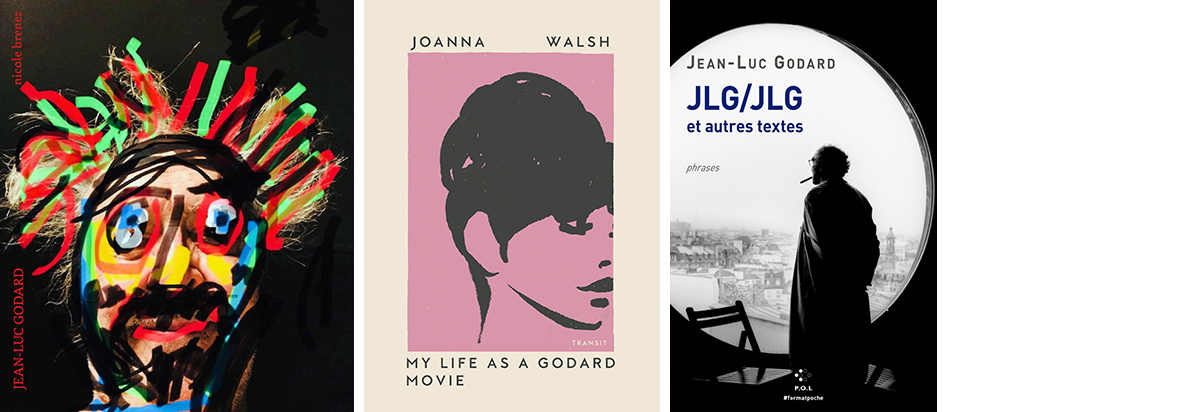
Announced just too late for our previous book round-up, Nicole Brenez’s Jean-Luc Godard will be one of the first major books of 2023. Following Manifestations (2020), this 400-page book containing unpublished documents is the second volume of Brenez’s Écrits politiques sur le cinéma et autres arts filmiques, a collection of writings on politically-engaged cinema practices. A short beautiful note from her to Godard about “torrents of love” – love streams – fills the back cover, and you can find the full table of contents on the website of the publishing house: de l’incidence éditeur. Brenez has previously co-edited Jean-Luc Godard, document (2006), was closely involved in the organisation of retrospectives of his work at Centre Pompidou (2006) and the Cinémathèque française (2020) and collaborated directly with Godard as ‘archaeologist’ on Le livre d'image (2018) and his following projects. Nicole Brenez will launch, present and sign the book on January 30 in bar Le 61 in Paris where it will be available for pre-sale before its official release on February 3.
In My Life as a Godard Movie, we watch the films of Jean-Luc Godard through the eyes of the British writer, artist and arts activist Joanna Walsh. She has crafted an intimate portrait of the way attention to works of art becomes attention to changes in ourselves. In a complex gesture of criticism, Walsh takes candid pleasure in beauty – the beauty of faces, figures, clothing and cities – while also querying its injustices. This publication has been available from Transit Books since last October. You can read an excerpt from the book on the website of 3:AM Magazine.
Film magazines such as Cahiers du cinéma, Sight & Sound and La Septième Obsession published special editions dedicated to Jean-Luc Godard after his death. The Japanese magazine Eureka has also released an extra January issue in his memory with interviews by Nicole Brenez and Anne Wiazemsky and texts by Daisuke Akasaka, Shigehiko Hasumi, Fabrice Aragno, Elias Sanbar, Frederic Jameson, Jonathan Rosenbaum and Philippe Azouri, among others.
Last November, Éditions P.O.L reissued the six books of Phrases that Godard published with them, accompanying the eponymous films: JLG/JLG, autoportrait de décembre (1996), For Ever Mozart (1996), Allemagne neuf zéro (1998), 2 × 50 ans de cinéma français (1998, with Anne-Marie Miéville), Les enfants jouent à la Russie (1998) and Éloge de l’amour (2001). This 400-page collection, JLG/JLG et autres textes: Phrases, brings together the entirety of these six books in paperback format. Constructed from what is said and thought in these films, the books constitute a “découpage dialogué” of each film: a succession of sentences, aphorisms, short stories, citations, which call forth the images and sounds of the films.
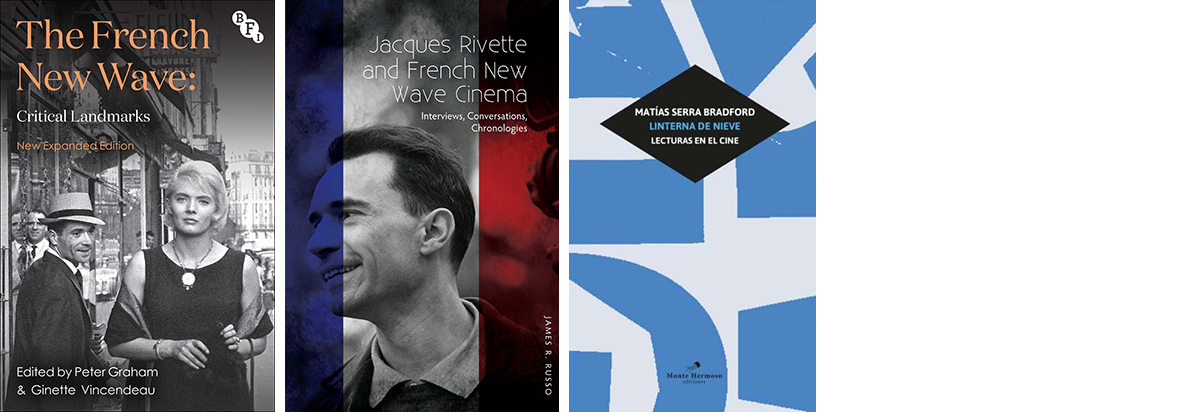
Jean-Luc Godard's À bout de souffle remains a central case study, but the new, third edition of the classic anthology The French New Wave: Critical Landmarks (1968/2009, BFI) has been expanded with several new sections, such as ‘The missing perspective’, on women directors (e.g. Jacqueline Audry and, yes, Paule Delsol), and notoriously overlooked women’s criticism from the period, including writing by Michèle Firk, Marie-Claire Ropars, Françoise Audé and Evelyne Sullerot. Here you can find the table of contents and read the preface and introduction of Ginette Vincendeau who co-edited the book together with the late Peter Graham.
Forthcoming in March, Jacques Rivette and French New Wave Cinema: Interviews, Conversations, Chronologies will be a first comprehensive English collection of the interviews of Jacques Rivette. Edited by James R. Russo, the pieces included in the book can be found under the Contents tab on the website of Sussex Academic Press. A draft for a letter on Jacques Rivette and an essay on Godard are also two among the many texts by Argentinian writer and translator Matías Serra Bradford collected in Linterna de nieve. Lecturas en el cine. Launched last September, this Spanish-language publication approaches cinema as a kind of snow lantern – linterna de nieve – to venture into the traffic between cinema and literature with essays on Daney, Ruiz, Duras, Marker, Schroeter, Fassbinder, Bergman, Jarman, Tarkovski, Mekas, Mizoguchi, and interviews with Kluge, Garrel and Kaurismäki, among others. You can find the table of contents on the website of the publisher, Monte Hermoso Ediciones.
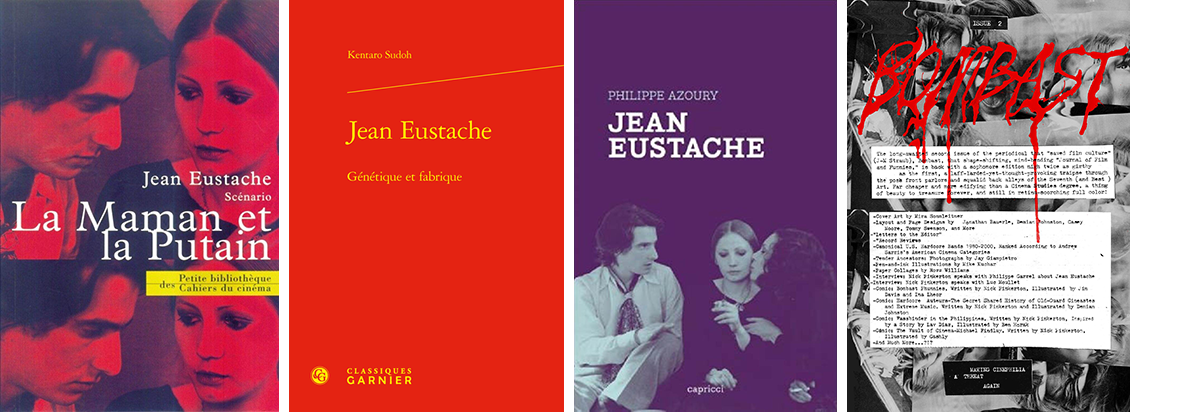
Post-Nouvelle vague filmmaker Jean Eustache is celebrated with two and a half new publications. Following the international tour of the restoration of the film, La Maman et la putain: Scénario will be reissued next March by Petite Bibliothèque des Cahiers du Cinéma from their original 1986 edition. For Jean Eustache: Génétique et fabrique,Kentaro Sudoh tapped previously unexploited archives and unpublished testimonies with former producers, directors of photography, assistants, actors, collaborators, friends and family. Out since last month, the book is based on the author’s 2016 doctoral study of the same title, supervised by Nicole Brenez. The website of publisher Classiques Garnier lists the table of contents. Next month, the critic Philippe Azoury will publish another book on Jean Eustache, a filmmaker on whom he has already written and lectured on several occasions. Forthcoming from the publisher Capricci, Jean Eustache explores the forms and motifs of his cinema to draw a portrait of a tortured artist whose life and work are inextricably linked, and whose films still serve as a sentimental education today.
Take note that a previously unpublished interview of Nick Pinkerton with Philippe Garrel about Jean Eustache will be part of the long-awaited second issue of Bombast, the “Journal of Film and Funnies” Pinkerton launched in May 2021. While in Paris last year, Pinkerton also met up with one of his heroes, Luc Moullet, the result of which we’ll also be able to discover in the new issue of Bombast, along with much more. Issue #2 is available for pre-order via the publisher, the Beacon Cinema.
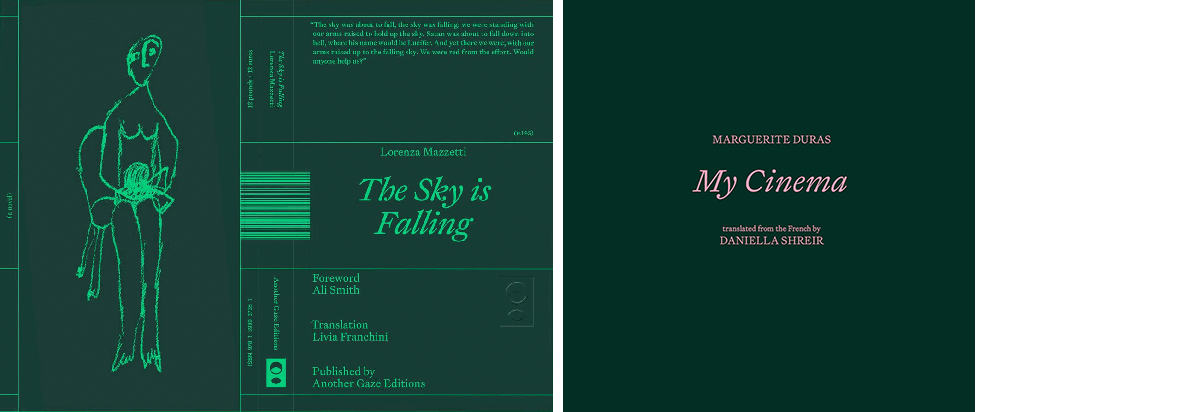
Launched this winter, Another Gaze Editions is a new publishing imprint created by Missouri Williams and Daniella Shreir, the editors of Another Gaze, a journal of film and feminisms. Another Gaze Editions will focus on new translations and editions of works of fiction and non-fiction by women filmmakers, women writers whose texts were the basis for well-known films, collections of writing by women film critics from around the world, and monographs of single films and filmmakers. Already announced in our book note of summer 2021 and out now, their first publication is a new translation of The Sky is Falling (Il cielo cade, 1961), the debut novel of Lorenza Mazzetti (1928-2020), who also drew, made films, and towards the end of her life ran a puppet theatre in Rome.
Following early 2023, the second publication of Another Gaze Editions will be Marguerite Duras’s My Cinema, a translation of Le cinéma que je fais (P.O.L, 2021) by Daniella Shreir herself. My Cinema is an extensive collection of writings by and interviews with Marguerite Duras about her cinematic oeuvre. Working chronologically through her 19 films made between 1966 and 1985, this 400-page volume includes non-standard press releases, notes to her actors, letters to funders, short essays, as well as some of the most significant and substantial interviews she gave about her cinematographic and writing practice (with filmmakers and critics including Jacques Rivette, Caroline Champetier and Jean Narboni). You can (pre)order both publications on the website of Another Gaze Editions.
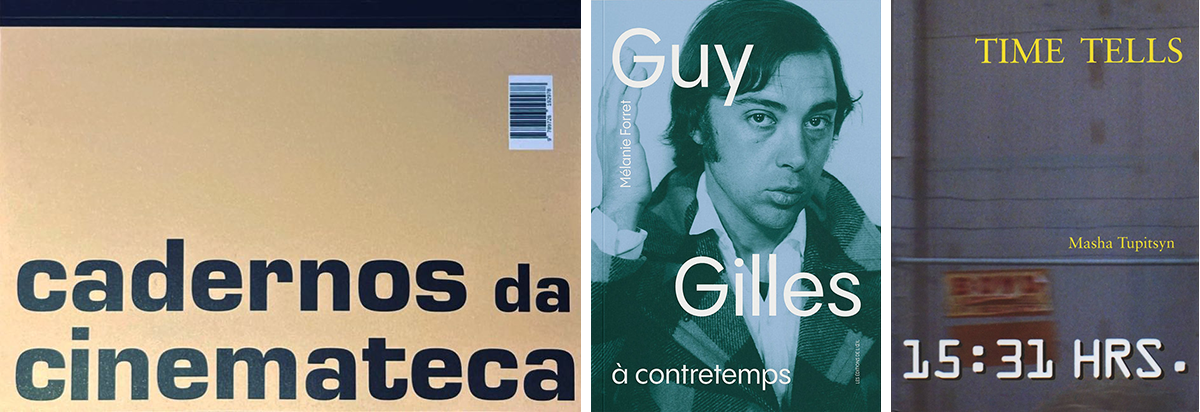
The Cinemateca Portuguesa launched the first volume of a new series of publications – Cadernos da Cinemateca – designed to accompany some major author screening cycles. The first director in focus in the Cadernos is Louis Malle, to whom the Cinemateca dedicated an almost complete retrospective last fall, entitled ‘Louis Malle: The Lone Rebel’.
In December, Les Éditions de l’Œil published a book on another outsider of the Nouvelle Vague generation. In Guy Gilles: à contretemps, Mélanie Forret explores Guy Gilles’s work against the times of the cinema of his time, perhaps out of time. The book is based on her 2018 doctoral thesis supervised by Serge Le Péron. Together with Prosper Hillairet, she also co-directed two documentaries on Guy Gilles, En complicité (31′) and D’un café l’autre (41′), to be found in Lobster Films’ 2020 box set with three of his films. Forret also contributed a text to the collection edited by Gaël Lépingle and Marcos Uzal, Guy Gilles: Un cinéaste au fil du temps (Yellow Now, 2014), the only other monograph on the work of Guy Gilles that has been enjoying renewed interest for several years now.
Using the method of the cinematic time-jump, Masha Tupitsyn’s Time Tells is a study of time, attention, loss, presence and chronopolitics but for our new age. In this first volume, the writer, critic and multimedia artist Tupitsyn covers wide-ranging cultural touchstones such as the 1990s television show Felicity, Hitchcock’s Vertigo, Luca Guadagnino’s Call Me by Your Name, Joan Didion’s The Year of Magical Thinking, Pretty Woman, Wong Kar-wai’s 2046, David Fincher’s Zodiac, Jean-Luc Godard, the Beastie Boys, Wim Wenders, the art of style, memory and music in the post-internet age, and the lost ontology of cinema. Using what Tupitsyn terms ‘screenshot criticism’, Time Tells makes innovative critical thinking accessible to anyone interested in American culture today. The American poet and professor Stacy Szymaszek finds it “an extraordinarily generous and profound hybrid text and manual that I will keep on hand at all times,” with “mid-way one of the brightest and most innovative pieces of film criticism I have ever read.” The book will be out this month from Hard Wait Press. The website of the distributor, Film Desk Books, offers two excerpts and some sample pages that give an idea of how Tupitsyn’s work will be laid out.
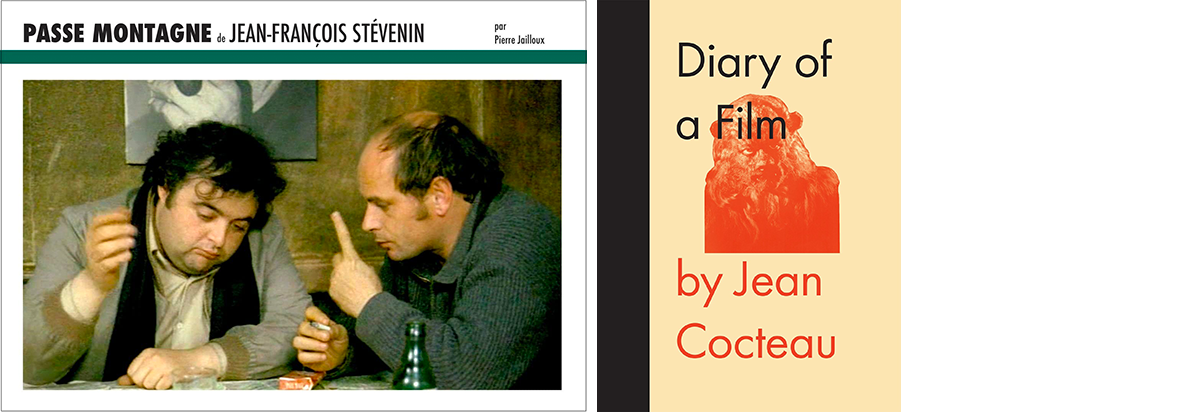
Editions Yellow Now continue their winning streak of well-chosen films with the next volume in the Côté Film series directed by Patrick Leboutte. The new book focuses on Passe Montagne (1979), the feature debut of Jean-François Stévenin (1944-2021) – once the assistant of Jacques Rivette, François Truffaut, Jacques Rozier, and unforgettable actor in Peaux de vaches (Patricia Mazuy, 1988) and so many other films. Forthcoming next April, Passe Montagne “does not propose to fill in the holes in the cheese, nor to straighten out an irresistibly convoluted film, but to curl up in its parentheses, to hop around on its points of suspension, and to let ourselves drift with it, without ever hoping to reach any reef. Let’s follow Jean-François Stévenin and his crew, led by his editor and accomplice Yann Dedet, in their childish and barbaric escapades, their toil and laziness.” In addition to Pierre Jailloux’s book-length essay, there is a vibrant portrait of Stévenin’s co-actor in the film, Jacques Villeret, by the critic Jean-Marie Samocki.
Another book focussing on one film, Jean Cocteau's Diary of a Film presents the director’s notebook of the making of La Belle et la bête (1946), beginning on the day before shooting started until the day after the film was first screened. Originally published in French in 1946, The Film Desk reissues the book this month in a new English translation by Nicholas Elliott, returning to the cover design of the first English translation by Ronald Duncan.
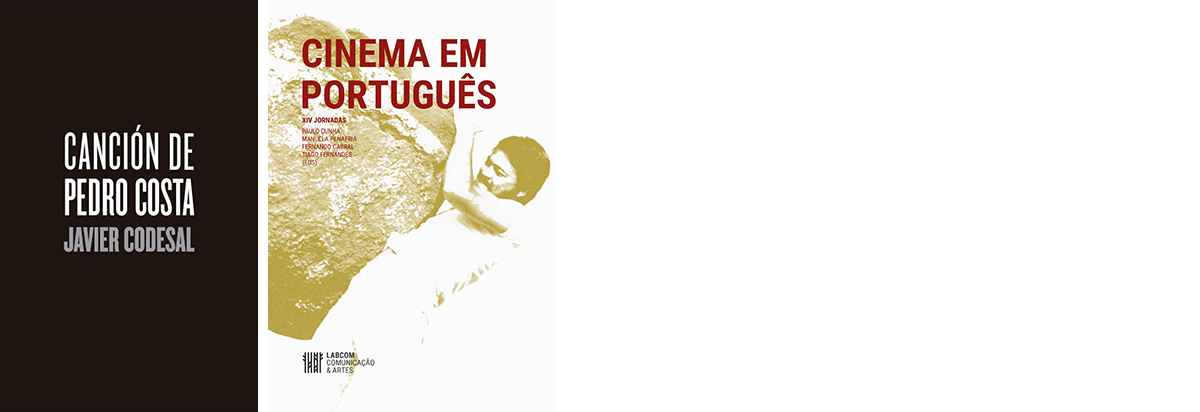
Canción de Pedro Costa accompanies the exhibition of the same name at La Virreina Centre de la Imatge in Barcelona. Pedro Costa made five works especially for this show, running until April 23. In this Spanish-language book, the curator of the exhibition, the artist and poet Javier Codesal, offers a reading of all of Costa’s films, with a special focus on the face, the voice and the song in his (recent) work. ‘One hundred thousand cigarettes: an aesthetic-political analysis of the cinema of Pedro Costa’ by Michelle Sales is one of the 16 contributions to Cinema Em Português: XIV Jornadas. Emanating from the 14th edition of the Jornadas on Portuguese-language cinema, organised by the LabCom research unit of the University of Beira Interior in Covilhã, this collection can be browsed or downloaded free of charge as a PDF book, but it is also available to order as a physical copy.
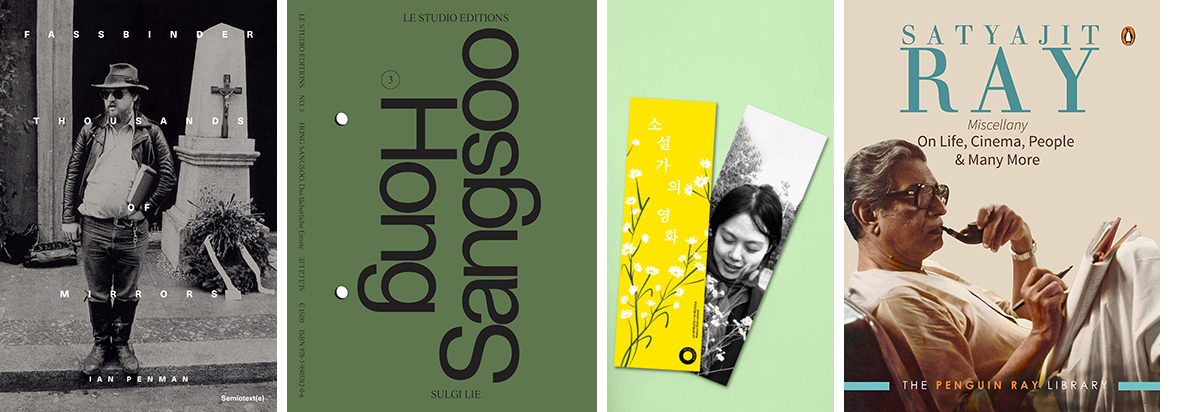
Melodrama, biography, cold war thriller, drug memoir, essay in fragments and mystery, Fassbinder: Thousands of Mirrors offers a kaleidoscopic study of the late West German filmmaker. Written quickly under a self-imposed deadline in the spirit of RWF himself, this is the first original full-length book by the British music journalist and critic Ian Penman (NME, Sight & Sound, The Wire, the Guardian, London Review of Books, etc.). Penman presents the filmmaker as an equivalent of what Baudelaire was to Benjamin: an urban poet in the turbulent, seeds-sown, messy era just before everything changed. This compelling story echoes the fragmentary and reflective works of writers like Roland Barthes and Emil Cioran, Eduardo Galeano and Alexander Kluge. Coming next April, the book will be published by Fitzcarraldo Editions and by Semiotext(e) in the United States.
The only contemporary filmmaker reaching Fassbinder-levels of prolificness, Hong Sang-soo is the subject of a first monograph in German. In Hong Sangsoo - Das lächerliche Ernste, Sulgi Lie investigates a double affect in Hong’s work, which he describes as “ridiculous seriousness”. Sulgi Lie is a Berlin-based film scholar, who has previously published Towards a Political Aesthetics of Cinema (2020) and Gehend Kommen - Adornos Slapstick: Charlie Chaplin & The Marx Brothers (2022). This elegantly designed booklet has been out since the end of October from the Viennese publishing house Le Studio. Meanwhile, the Spanish film distributor Atalante designed an exclusive and limited-edition bookmark of Hong Sang-soo’s The Novelist’s Film (2022). You receive it as a gift with a ticket for the film in selected cinemas. It offers a 5 percent discount on book purchases at associated bookstores across the country until the end of this month, although it is also an object of desire one may get hold of on the online second-hand market.
In our book note of spring/summer 2021, we announced Penguin’s new Satyajit Ray Library series with their first publication, Three Rays. Now, the second of what will be five volumes of previously unpublished work has been released: Satyajit Ray Miscellany: On Life, Cinema, People & Much More. This collection unearths more than seventy of his rarest essays on filmmaking, sketches of scenarios, manuscripts, handwritten notes, musical notations, autobiographical pieces, cover designs, illustrations, photographs, portraits, and doodles of artists.
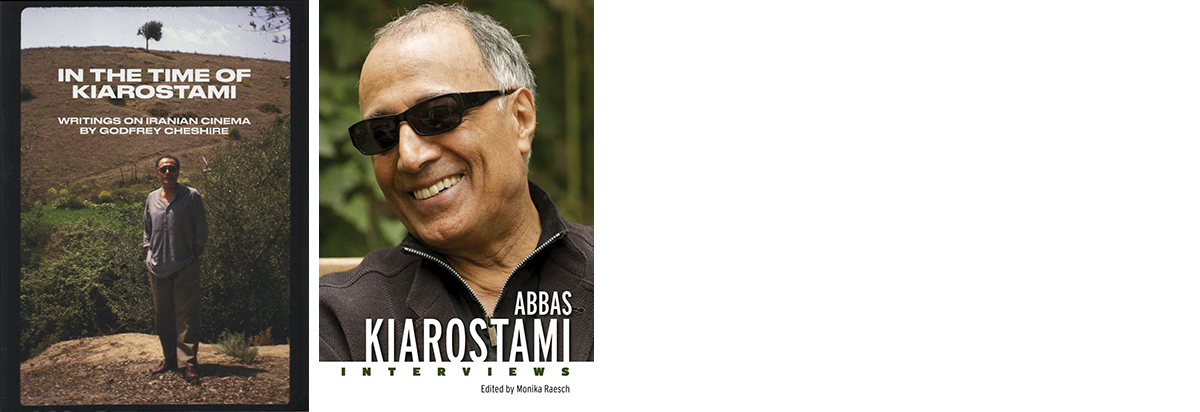
Many years in the making and now finally published last month, In the Time of Kiarostami: Writings on Iranian Cinema collects many of the texts of Godfrey Cheshire, one of the earliest and crucial champions of Iranian cinema in the English-speaking world. Including pieces written over the years along with new writings, the book presents a detailed, prismatic set of reflections on Iranian cinema from its beginnings until now. This collection includes ‘My Journey with Iranian Cinema’, Cheshire’s personal overview of his long involvement with Iran and its film culture; ‘First Encounter’, his groundbreaking 1993 Film Comment article that initiated his study of Iranian cinema; ‘Inside the Islamic Republic’, with reports on several visits to Iran from 1997 to 2017; ‘The Backstory’, a history of Iranian cinema from 1900 until Close-Up (1990); ‘Abbas Kiarostami, Cine-master’, containing detailed explorations of many of his films, as well as accounts of Cheshire’s interactions with Kiarostami; ‘Directors and Films’, with profiles and reviews of artists including Dariush Mehrjui, Mohsen Makhmalbaf, Jafar Panahi, Asghar Farhadi, Mohammad Rasoulof, Majid Majidi, Bahman Ghobadi and others; ‘Aspects of Iranian Cinema’ including reports and essays on topics including Ebrahim Golestan and The House Is Black; pieces on cinema pioneers Fereydoun Hoveyda and Farokh Ghaffary, the tradition of Iranian films about children, and more. Called “his definitive book” by filmmaker Ramin Bahrani, In the Time of Kiarostami follows Cheshire’s Conversations with Kiarostami (2019), released by the same publisher, The Film Desk.
Abbas Kiarostami is also one of the upcoming artists in focus in the Conversations with Filmmakers series in which the University Press of Mississippi has been releasing interview collections at an incredible pace. Forthcoming in May, Abbas Kiarostami: Interviews brings together 18 interviews (several translated into English for the first time), lectures, and other materials that span Kiarostami’s career and offer a picture of the filmmaker through his conversations with journalists, film scholars, critics, students and audience members. Previous or future volumes in this series collect interviews with Christian Petzold, Louis Malle, Su Friedrich, Otto Preminger, Alain Resnais and David Cronenberg, among others.
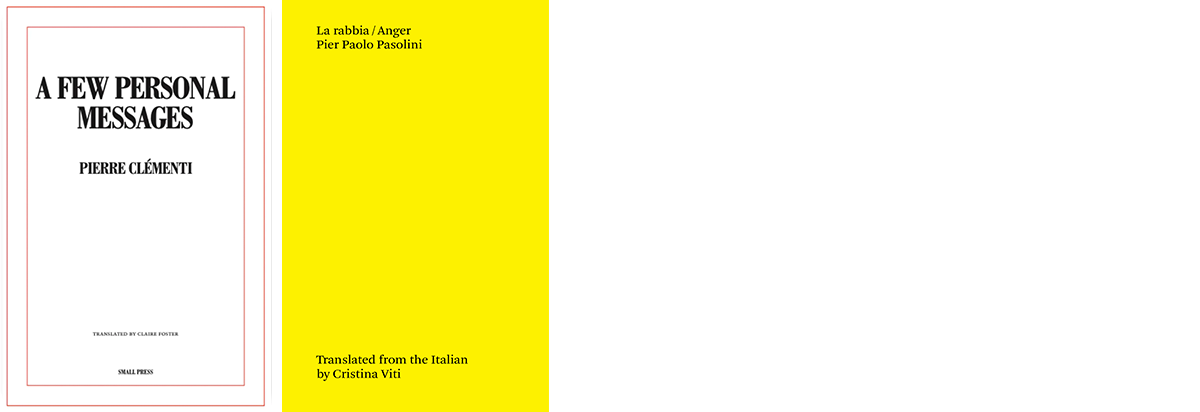
Last season, we saw the arrival of many memoirs. Let us start with A Few Personal Messages by the actor and experimental filmmaker Pierre Clémenti, who wrote this prison memoir when spending 17 months in an Italian jail for supposed drug possession in 1972. Clémenti’s cri de coeurand manifesto has been available from Small Press since October. This first English translation by Claire Foster of Quelques messages personnels (S.E.F., 1973) coincides with a tour of the restorations of the integral body of films made by Clémenti (MoMA, Austrian Film Museum, L.A., etc.) in the presence of his son Balthazar Clémenti, who wrote the introduction and afterword of the book.
A similarly literary expression of political and poetic rage, restless and relentless fury, passion, outrage and grief at inequity can be found in Pier Paolo Pasolini’s ground-breaking, filmic work of prose and verse, La rabbia / Anger, available since last month in a first-time English language translation by Cristina Viti. In this remarkable set of poems, composed in 1962 to accompany his film by that title, Pasolini’s lens pans over the Soviet repression in Hungary, the Cuban revolution, the utopian object of space exploration, political imprisonment in Algeria, the liberation of the former European colonies, the election of Pope John XXIII, the prospect of revolution in Africa, the Middle East, Europe and Latin America, and the death of Marilyn Monroe. On the website of Tenement Press, you can read Roberto Chiesi’s introduction to the work. This book goes well with last November’s release of Fireflies Press’s Writing on Burning Paper, announced in our previous spring/summer book note as a set of two complementary volumes that slide into one another, with the smaller one featuring Pasolini's epic autobiographical poem ‘Poet of the Ashes’ in a revised translation.
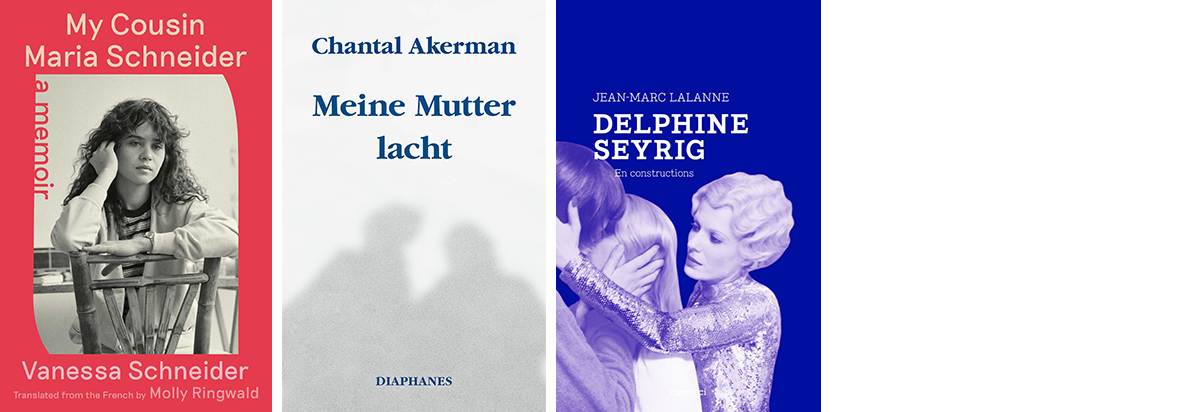
The same year as Pierre Clémenti’s imprisonment, Bernardo Bertolucci – with whom Clémenti had just made Partner (1968) and Il Conformista (1970) in Italy, and in between Porcile (1969) with Pasolini – released Last Tango in Paris (1972), for which the crew had exploited and traumatised the nineteen-year-old French actress Maria Schneider, an experience that led her to a figurative confinement, depression, drug addiction and several suicide attempts. Her younger cousin, the journalist and novelist Vanessa Schneider, wrote a memoir and tribute to her, Tu t’appelais Maria Schneider (Grasset, 2018). With My Cousin Maria Schneider: A Memoir, actress, author and singer Molly Ringwald made the first English translation, appearing in April with Simon & Schuster.
Also note that Chantal Akerman’s memoir, Ma mère rit (2013/2021), is now available in a German translation from Diaphanes. Meine Mutter lacht follows earlier translations into English (Silver Press/The Song Cave, 2019), Spanish (Ocho Milímetros, 2019; Mangos de Hacha, 2020) and Polish (Nowe Horyzonty, 2021). With the selection of Chantal Akerman’s Jeane Dielman as the greatest film of all time in the Sight & Sound poll, the image of Delphine Seyrig has been making the rounds in the last months. In February, a new book on this leading lady of the international auteur cinema of the 1960s and 1970s will be published by Capricci. In Delphine Seyrig. En constructions, fomer editor-in-chief of Cahiers and Inrocks, Jean-Marc Lalanne, takes a closer look at her work as an actress and director, but also her public standpoints, particularly on the feminist cause.
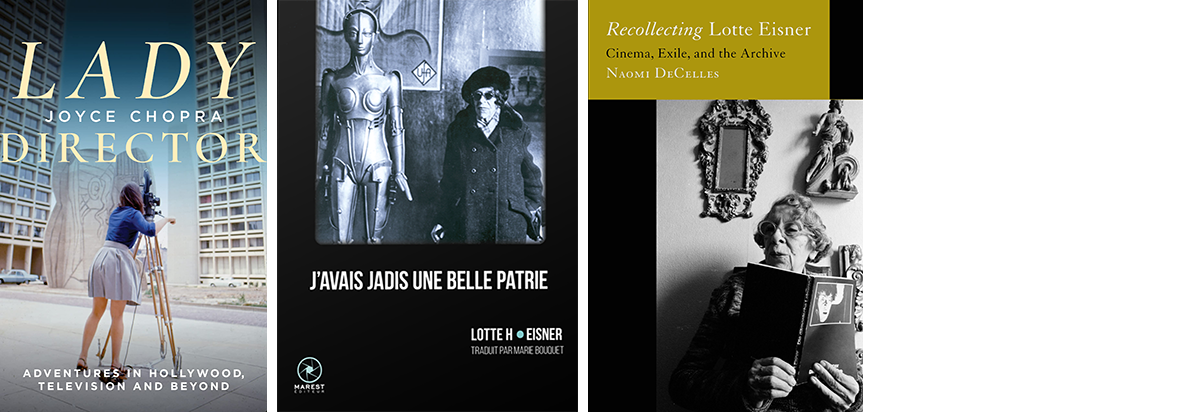
With Lady Director: Adventures in Hollywood, Television and Beyond, Joyce Chopra (1936) comes with another intimate memoir of a filmmaker’s development as a woman in both art and life. She shares how she learned to navigate the deeply embedded sexism of the film industry, helping to pave the way for a generation of women filmmakers who would come after her. Chopra started out making documentary films with the legendary D. A. Pennebaker, before making her groundbreaking autobiographical short, Joyce at 34 (together with Claudia Weill, 1972) in which she stars as a young mother, and her Sundance-winning first feature, Smooth Talk (1985) with an 18-year-old Laura Dern in the lead. The book was published in November by City Lights.
During the last years of her life, Lotte Eisner dictated her memoirs to Martje Grohmann, the ex-wife of Werner Herzog – the two of them preface and postface the book. It was then posthumously published in 1984 as Ich hatte einst ein schönes Vaterland: Memoiren (Heidelberg: Wunderhorn). Lotte Eisner (1896-1983) was a German-French writer, film critic, curator and archivist who, together with Henri Langlois and others, co-founded the Cinémathèque française where she worked for over forty years as Langlois’s closest collaborator and Chief Curator. Last October, Marest presented Marie Bouquet’s French translation of her memoir, J’avais jadis une belle patrie: Mémoires. Apparently, the book has also been translated into English by Sabine Berendse and Paul Clement as I Once Had a Beautiful Fatherland: Memoirs but remains unpublished.
Simultaneously, the film historian and translator Naomi DeCelles comes with the first in-depth examination of Lotte Eisner’s transnational career as a film journalist, archivist, and historian. Recollecting Lotte Eisner is based on extensive multilingual archival research, the excavation of a rich corpus of previously overlooked materials and introduces samples of Eisner’s writing in translation. You can find the table of contents and read an excerpt on the website of the University of California Press.
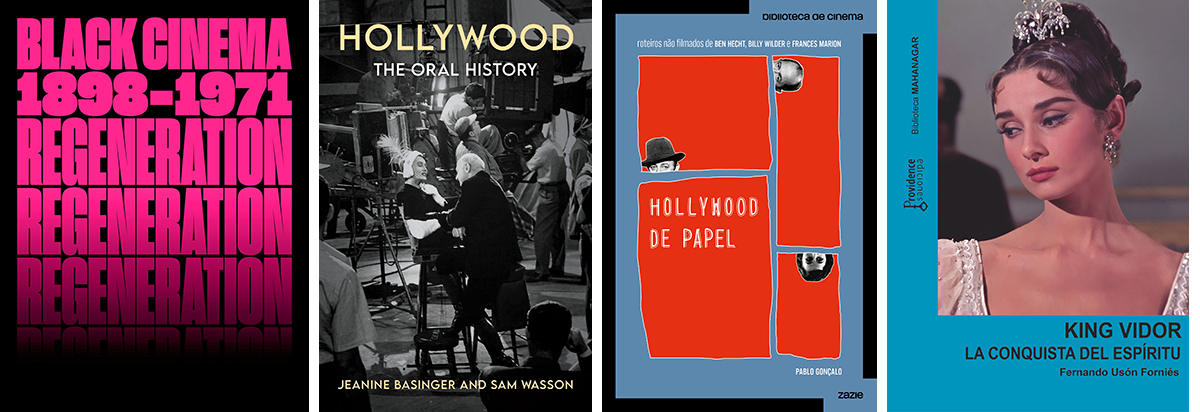
A next cluster of books consists of retakes on or rewritings of Classical Hollywood history. Regeneration: Black Cinema, 1898-1971 accompanies a first-of-its-kind exhibition (and screening series) at the Academy Museum of Motion Pictures exploring seven decades of Black participation in American cinema, running until April 9. Black film artists not only developed an enduring independent tradition but also transformed mainstream Hollywood, while Black performers, producers and directors had a vast and resounding impact. Amplifying this underrepresented history, the book features an in-depth curatorial essay and case-study texts. An extensive filmography and chronology offer an essential resource for anyone interested in Black cinema. This reference work has been available from DelMonico Books and the Academy Museum since last October.
Out with Harper since November, Hollywood: The Oral History tries to bring the real, insider story of Hollywood as told by such luminaries as Steven Spielberg, Frank Capra, Katharine Hepburn, Harold Lloyd and nearly four hundred others, including musicians, costumers, art directors, cinematographers, writers, sound men, editors, make-up artists and even script timers, messengers and publicists. Assembled from the American Film Institute’s treasure trove of interviews, the film historians Jeanine Basinger and Sam Wasson have undertaken the monumental task of digesting tens of thousands of hours of talk and weaving it into a definitive portrait and a unique first-hand account of workaday Hollywood. This volume is a gold mine of production details, backroom deals, surprising insights and revelations and a lot of inside gossip. The Guardian and Booklist speak of “surely the most comprehensive portrait of America’s dream factory ever committed to paper,” and “as close to a definitive history of American cinema as we’ve seen so far”. You can find the table of contents and read a sample on the website of the publisher.
Hollywood de papel also takes a look at the backstage of the Hollywood studio system by illuminating unfilmed scripts of three of the biggest screenwriters: Ben Hecht, Billy Wilder and Frances Marion. Including documents, correspondence and confidential reports, the book is the result of unprecedented postdoctoral research at the University of Chicago by the critic, curator, screenwriter and film scholar Pablo Gonçalo and presents a Hollywood that is somewhat different from the one we are used to: “Many of the unpublished stories that I discovered and bring in the book directly challenge the moral precepts of the censorship code. They are stories that are very unknown in the bibliography and in American research on Hollywood while they are beautiful, important narratives that show another Hollywood.” Published last October, this Portuguese-language book inaugurates the new Cinema Library collection of the independent Rio- and Copenhagen-based publishing house Zazie Edições, only active as print publisher since 2021.
Luckily some of Ben Hecht’s scripts did get filmed by King Vidor (Duel in the Sun, Comrade X, Light’s Diamond Jubilee). King Vidor: La Conquista del Espíritu is an almost 800-page bible with 1,700 illustrations supporting the analyses and covering all of his films, the famous masterpieces but also other extraordinary films nowadays almost invisible, some even only accessible in the archives, such as Bud’s Recruit, The Other Half, The Family Honor, Conquering the Woman, Wine of Youth, His Hour or Proud Flesh. Author Fernando Usón Forniés, a Spanish film writer with a PhD in mathematics, already released another study on Fritz Lang two years ago with the same publisher, Providence Ediciones. He himself calls his new Vidor book, “surely the most comprehensive study to date on one of cinema's indispensable giants and one of the most influential of all history, if not the most.” In case anyone wonders, this is not a reissue of the author’s two volumes of the same name, published by Arkadin Ediciones in 2016. The text has been thoroughly revised, passages have been added, more and higher-quality images better interact with the corresponding analyses and text now on larger pages, and this all in a single volume.
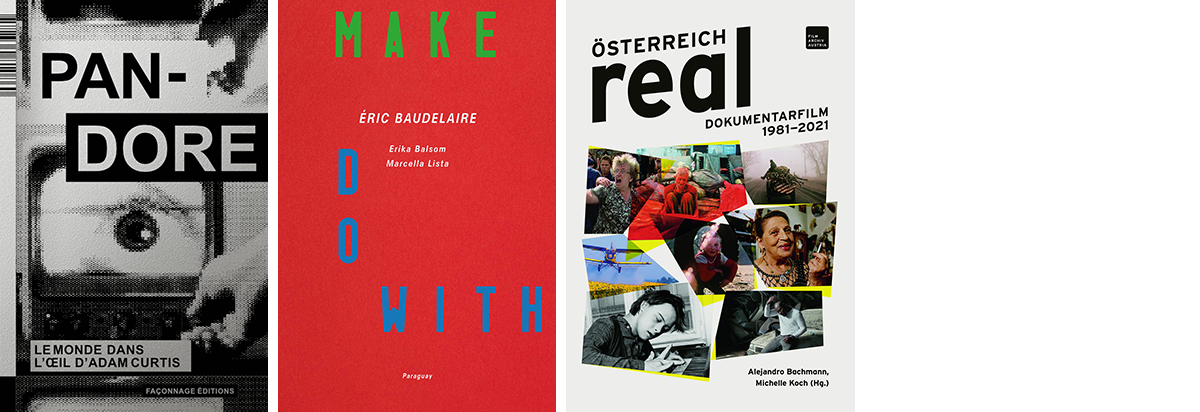
Last month, the independent publishing house Façonnage released the first-ever monograph on the work of the English documentary filmmaker Adam Curtis (1955). Pandore: Le Monde dans l’œil d’Adam Curtis covers his entire filmography, spanning more than thirty years and drawing on the immeasurable and unique video archives of the BBC, where he spent his entire career dissecting the systems that govern us through his often vertiginous montages. The collection contains an extensive, almost 100-page interview with Curtis. The authors include Cahiers du cinéma’s Fernando Ganzo and Les Inrockutibles’s Jacky Goldberg, among others.
Launched last November by the cooperative publishing house Paraguay Press in a separate French and English edition, Eric Baudelaire: Faire Avec / Make, Do, With is the first monograph devoted to Éric Baudelaire’s work and collaborative method. Baudelaire’s films (Un film dramatique, The Anabasis, etc.) are made with the people whose stories they tell: revolutionary filmmakers and activists, teenagers, secessionists or terrorists. Their lives, their ethical choices and their relationship to images are the exemplary materials of a cinema that rethinks the documentary form, but they are also at the centre of a collective work that Baudelaire has developed over his curatorial projects and exhibitions, and which is an integral part of his artistic practice. In Make, Do, With, Erika Balsom and Marcella Lista trace the connections between these two fields of experience – films and exhibitions – in two texts that are themselves part of a long-term dialogue between the artist and the two authors.
If Baudelaire's cinema “rethinks the documentary form,” Österreich Real: Dokumentarfilm 1981-2021 describes documentary film in Austria as a multiplicity of cinematic forms and approaches to the real in 25 long and 54 short contributions, recent and historical texts and over 300 illustrations. Not a history as a chronological sequence of singular works, this anthology rather spans and surveys the field of a documentary practice that resists the formatting of the visual, the national and reality on multiple levels. Published by the Austrian Film Archive, the book includes texts by the co-editor Alejandro Bachmann, Christa Blümlinger, Lukas Foerster, Stefan Grissemann, Cristina Nord and Carolin Weidner, among others.
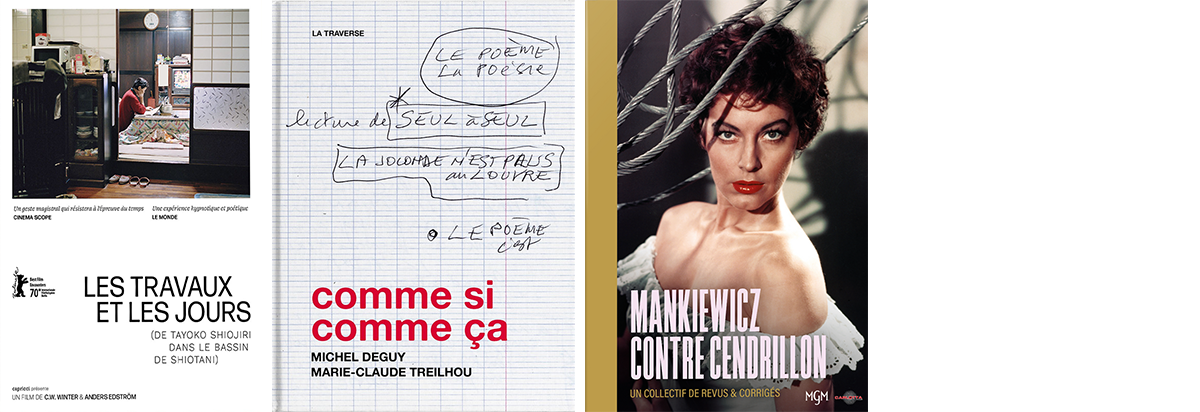
The Austrian Film Archive also put out DVDs of Batang West Side (Lav Diaz, 2001) and Grand Opera (James Benning, 1978) in May and December, respectively. Each includes a 20-page booklet with a text by or interview with the filmmaker, next to other contributions. More (substantial) DVD books: Capricci’s October release of C. W. Winter & Anders Edström’s extraordinary The Works and Days (2020) comes with a 128-page French-language publication, including interviews, texts by Chris Fujiwara, Alan Licht and Patrick Holzapfel, the diary of Tayoko Shiojiri, photographs of Anders Edström and other documents and ancillary materials.
Carlotta again includes 160-page publications in their Ultra Collector boxsets (#23 and #24) of Coming Home (Hal Ashby, 1978) and The Barefoot Contessa (Joseph L. Mankiewicz, 1954), released in September and November, respectively. The Hal Ashby edition contains an unpublished booklet, L’Esprit retrouvé, written by film historian Jean-Baptiste Thoret, and accompanied by excerpts from a working script of the film. The equally unique booklet, Mankiewicz contre Cendrillon, coming with the release of The Barefoot Contessa has been collectively coordinated by Marc Moquin and Alexandre Piletitch of the film magazine Revus & Corrigés. Both books include 50 archival photos.
After their invaluable work on Marie-Claude Treilhou’s Simone Barbès ou la vertu (1980), Les Éditions de l’Œil released Comme si, comme ça (2019), her film with and about the distinguished French poet Michel Deguy who passed away in February last year at the age of 91. Published in November, the 64-page DVD book includes two poems by Deguy, Treilhou’s working notes and texts on Deguy and their collaboration.
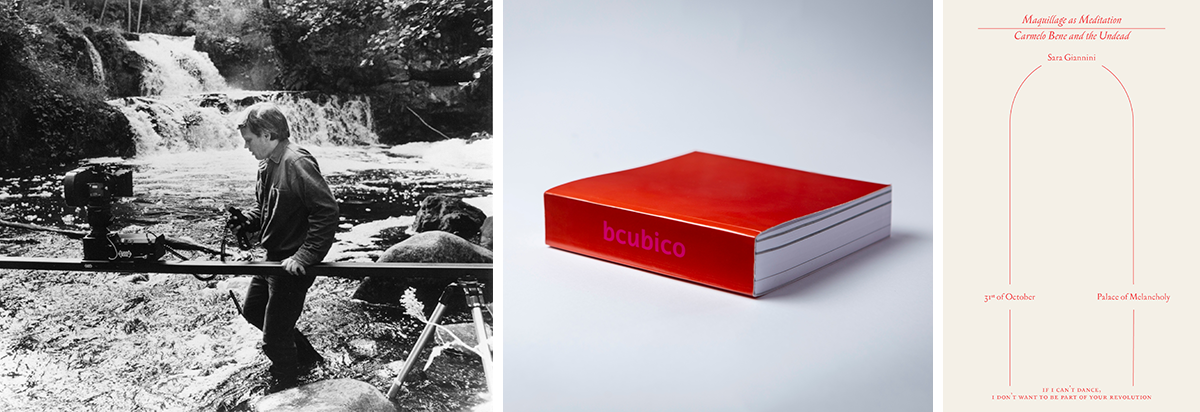
Edited by Martin Grennberger and Daniel A. Swarthnas, Claes Söderquist. Filmen och tidens passager [The film and the passage of time] is a new monograph on the Swedish experimental filmmaker who has been working since the early sixties. The book is a culmination of many years of conversations, collaborations and curating screenings of his films both nationally and internationally. A shared interest in the history of experimental film, where Söderquist’s own films make a contribution that is unusual in a Swedish context, has led the editors and authors to discuss his work in a larger international context. Here, too, Söderquist’s efforts as curator of extensive film screening series both in Sweden (he was the driving force and chairman of Filmform for 20 years) and abroad have been important. The book consists of an introduction, two interviews, texts by filmmakers Els van Riel, Nicky Hamlyn, Chris Kennedy and film scholars Masha Matzke and Astrid Söderbergh Widding, next to extensive visual material. It was launched in Stockholm last November with a film programme and artist talk with Claes Söderquist (1939).
Based in Recife, Brazil, Bcubico was a space and platform for the exhibition of and reflection on experimental cinema and (video) art, active between 2011 and 2015. They’ve now put out a 605-page publication, Bcubico, that is an echo of this experience through texts, testimonials, stories and photos. Edited by Edson Barrus and Yann Beauvais, the book contains contributions by Anthony McCall, Malcom Le Grice, Matthias Müller, Mike Hoolboom, Paul Sharits, Peggy Ahwesh and Valie Export, among others. It’s a trilingual publication with texts in Portuguese, English and French. One thousand copies of the book were printed last September, but is also available to download free of charge on the website of the publishing house: .txt texto de cinema. Although Bcubico’s finitude had always been a fact they've worked with, the building’s structural problems, the landlord’s negligence and the possible collapse of the balcony were reasons why they put an end to the project.
Published one year ago and thus stricto sensu not a new work, Maquillage as Meditation: Carmelo Bene and the Undead is nevertheless a book (or script) that “happens, has happened and will happen on the 31st of October.” Every time it is opened, it leads the reader in the midst of All Saints Eve, the night in which the other side, the ‘off-scene’, is on scene. The setting is the Palace of Melancholy, a place for mourning, longing, remembering, and aching. In this temporal and spatial loop, the Amsterdam-based author and curator Sara Giannini summons the spectres left behind by the controversial Italian actor, author, director, philosopher and public persona Carmelo Bene (1937-2002). The complicated legacy of this figure is approached by Giannini through inner voices of dissent, shame and rebellion, as well as through imaginative historical gatherings. Published by the Amsterdam-based art organisation If I Can’t Dance..., Maquillage as Meditation – fabulous title – takes readers through Giannini’s personal journey as she tries to face her conflicting feelings toward Bene, recalling her first encounter with him on television at the age of ten. In the process, she speculates on new constellations through which to understand his practice and context. In her company and support, Giannini has invited three travelling companions – friends and allies who bring with them their own critical examinations and excursions into what Bene has meant, and still means, for their lives and practices.
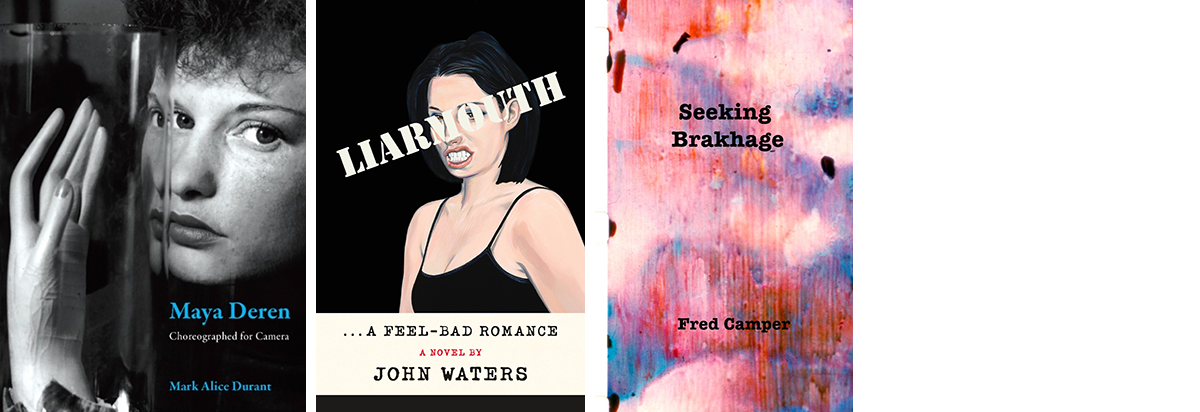
The Chicago-based film writer and lecturer Fred Camper has written about the films of Stan Brakhage for over five decades, from 1966, when he was 18, to 2021. In Seeking Brakhage, he has collected almost all of his writing on the filmmaker for the first time in a single volume. Originally published in varied forms – articles, programme notes for screenings and retrospectives or liner notes – his texts have until now been difficult to appreciate in their entirety. Introduced by P. Adams Sitney, this 455-page collection includes 56 colour scans of Brakhage’s films from the many that Camper has made over the course of two decades. Seeking Brakhage will be available from Eyewash Books as print publication and ebook starting January 14, which is the ninetieth anniversary of Brakhage’s birth. Last November, Camper already gave a Virtual Book Talk that has been recorded. On the occasion of the publication, Camper was invited to curate two Brakhage film programmes at the Museum of the Moving Image and Anthology Film Archives, screening between January 14 and 16 and at both venues accompanied by a programme of his own, rarely screened, early 16mm films. Camper says, “my fondest hope for this book as that it encourages more screenings of Brakhage’s work on film, and I am open to considering curating and appearing at such events.”
Stan Brakhage once said that Maya Deren was “the mother of us all.” Another life’s work 20 years in the making, Maya Deren: Choreographed for Camera is the first full biography of the pioneering experimental filmmaker, prolific writer, accomplished photographer and crusader for a personal and poetic cinema. Based on years of research and interviews with some of Deren’s closest collaborators, the Baltimore-based artist and writer Mark Alice Durant creates a vivid and accessible narrative exploring the complexities and contradictions in the life and work of the artist. Generously illustrated with film stills and photographs, the book was published this fall by Saint Lucy Books. The critic Richard Brody praised the “fanatical research,” and J. Hoberman called it an “illuminating, loving and long-overdue biography.” Durant will present a selection of Deren’s short films, do a book reading and signing at the National Gallery of Art in Washington, DC, on February 4.
Another first, the cult filmmaker John Waters (Hairspray, Pink Flamingos, Cecil B. Demented, Polyester) has written a novel. Liarmouth: A Feel-Bad Romance follows Marsha Sprinkle, a suitcase thief, scammer, master of disguise and member of a family with three generations of women who plan to confront or kill one another. The book was published earlier last year by Farrar, Straus and Giroux, but Waters is now also adapting it into his first film in almost two decades.
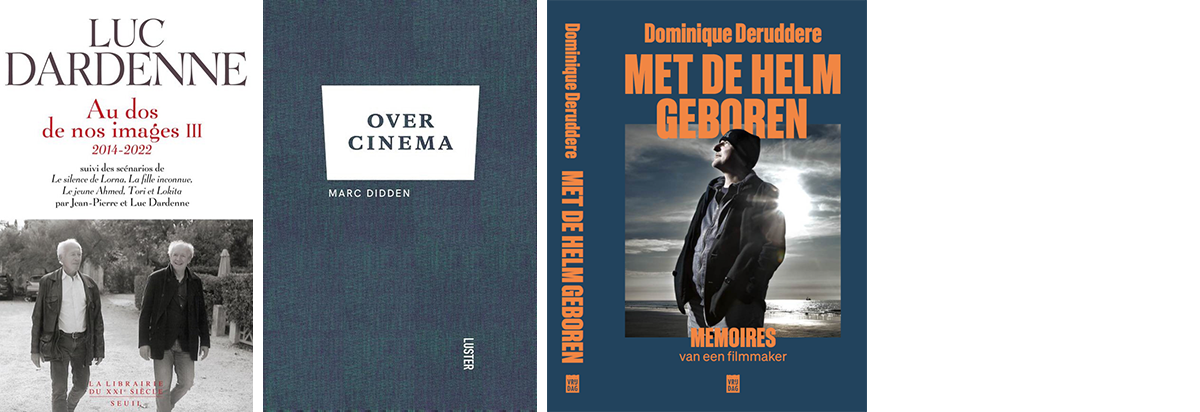
There’s a rather big batch of Belgian film books this season. January 13, Au dos de nos images III (2014-2022) will be released from Éditions du Seuil. This is the third part in the publication series of the shooting scripts of the Dardenne brothers, and, more importantly, of a selection of writings and excerpts from Luc Dardenne’s working journal of about the past ten years, an instrumental basis for writing their scenarios in the first place. This new edition follows on part I (1991-2005) and part II (2005-2014), published in 2005 and 2015 respectively. This time, the included scripts are of the films Le Silence de Lorna, La Fille inconnue, Le Jeune Ahmed and Tori et Lokita. Luc Dardenne writes: “It’s strange, but I have the impression that without [my journal], even if I write in it less often, I would not be able to think of a film with my brother. This is my way of being together to make films, my brother has another way, the important thing is that we both want to make the same film.” The first part has been translated into English as On the Back of Our Images (1991-2005) in 2019. Featherproof Books is preparing the translation of the second volume for a September 2023 release. On Sabzian, you can find a selection of fragments of Au dos de nos images in French and Dutch in a first and second part.
The next book includes a conversation with the Dardenne brothers. It’s one of the 13 interviews that the journalist, screenwriter, teacher and filmmaker Marc Didden (Brussels by Night) collected in the second part of his new book Over Cinema. The first part presents his “veiled memoirs” and reads as a personal history of the Belgian and Dutch film and television world. Among the other included interviews, mostly conducted for the Belgian weekly Humo, one finds Didden’s encounters with Woody Allen, Mel Brooks, Martin Scorsese, Ken Loach, Mike Leigh and more. The book has been available since last October from Luster.
Together with the actor Josse De Pauw, the musician Arno Hintjens, the theatre director Jan Decorte and the film director Dominique Deruddere, Marc Didden is part of a group of friends who call themselves the ‘hombres complicados’, a name coined by De Pauw in 1987 and also the title of a film they made together ten years later. A couple months after Didden, a second member of the ‘hombres complicados’ published his memoirs. In Met de helm geboren: Memoires van een filmmaker, Dominique Deruddere tells how he grew up in the turbulent sixties, how he started out, finally went on to film the stories he wanted and the wondrous encounters this brought about (Francis Ford Coppola, Madonna, Charles Bukowski, Faye Dunaway, etc.), but “it’s mostly about the films I didn’t make. Projects that have fallen through and that no one knows about.” Published by Uitgeverij Vrijdag, the book will be launched on January 28 in the presence of Deruddere, Marc Didden and Josse De Pauw at Filmfestival Oostende that opens with Deruddere’s new film, The Chapel, and honours him with a retrospective (Crazy Love, Wait Until Spring Bandini, Iedereen Beroemd, etc.).
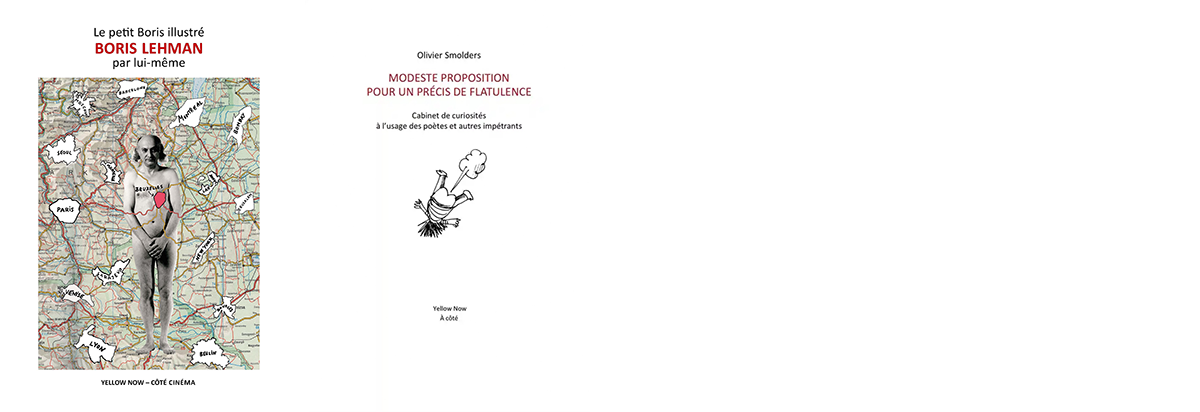
Next up are three books published on and by Belgian filmmakers by Editions Yellow Now. Next February, the legendary Boris Lehman releases a portrait of himself, presented in the form of cleverly arranged fragments, and mixing drawings, photos, poems and various documents. The artist’s book, Le Petit Boris illustré: Boris Lehman par lui-même, promises to be a true encyclopaedia which collects, from more than half a century, some scattered pieces of his life. As in a game of mirrors, we’ll find the filmmaker multiplied to the infinite over more than 700 pages.
Inspired by a recent rediscovery of Louis de Funès classic La Soupe aux choux (The Cabbage Soup, 1981), author and filmmaker Olivier Smolders (Voyage autour de ma chambre, Seuls) found himself inventorying farts, with an eye to a broader study. Modeste Proposition pour un précis de flatulence. Cabinet de curiosités à l’usage des poètes et autres impétrants is about nothing less than redefining our relationship to the world through the prism of our fascination for the mire, understood that it often baldly borders on the sublime. Forthcoming in June, Smolders’s booklet will bring “a breath of fresh air.”
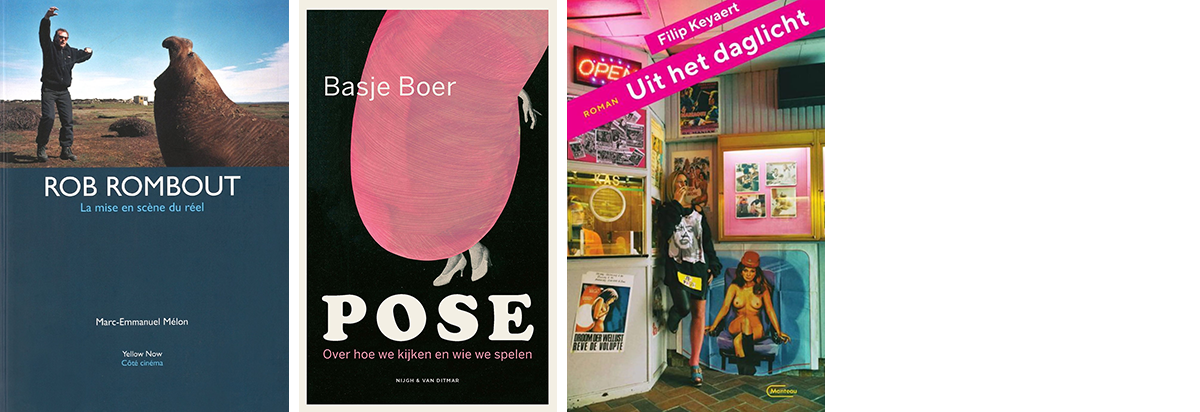
Earlier last year, Editions Yellow Now released a monograph on the work of the Brussels-based filmmaker and teacher Rob Rombout. Written by the film professor Marc-Emmanuel Mélon, Rob Rombout: La mise en scène du reel adopts a structure as diversified as Rombout’s cinema that has always been straddling fiction and reality. A first text considers the aesthetic concerns of his work. This is followed by in-depth analyses of more than ten of his key films, illustrated with photograms, location shots and completed by contributions from the filmmaker who, interviewed by Guy Jungblut, details a multitude of aspects of his work in terms of production, methods and stylistic choices. QR codes give access to film clips.
Equally fascinated with how we fit life into narratives, Pose. Over hoe we kijken en wie we spelen questions what it means when reality becomes entangled with stories, especially when women see themselves reflected in stereotypical roles, such as victim, goddess or femme fatale. Intuitively and associatively, writer Basje Boer uses classic and popular films, personas, characters and pop-culture icons to show how attractive the game of watching and being watched is – and also how dangerous. Should we resist the clichés or is the role-playing game too precious to us, she wonders in this new collection of Dutch-language essays, published last month by Nijgh & Van Ditmar. You can read the introduction on the website of Athenaeum and two of the included essays on the ‘cool girl’ and Vertigo in De Groene Amsterdammer and De Filmkrant, respectively.
Many of the characters are quite literarly posing in Filip Keyaert’s second novel, Uit het Daglicht. In a dingy 1979 erotic cinema near Brussels’s South Station, the protagonist, Sonja, fills her days redecorating the shop window or working behind the counter. Under the all-seeing eye of the older and somewhat timid cinema owner, Marcel, she clings to the love of Angela, the stripper who dances the shows together, and Gilberte, an angel-faced street prostitute. Featuring strong women in a male-ruled world of sex theatres, peep shows and backstreet bars, the novel was published last September by Manteau who advertises the book as “reminiscent of the work of Gerard Reve.” The Denderleeuw-based writer already set his debut novel, Sterven met tussenpozen (2021), in the world of video stores in the city of Aalst during the mid-80s. The prolific novelist Herman Brusselmans then wrote, “finally Flemish literature gets a redeeming new injection.”
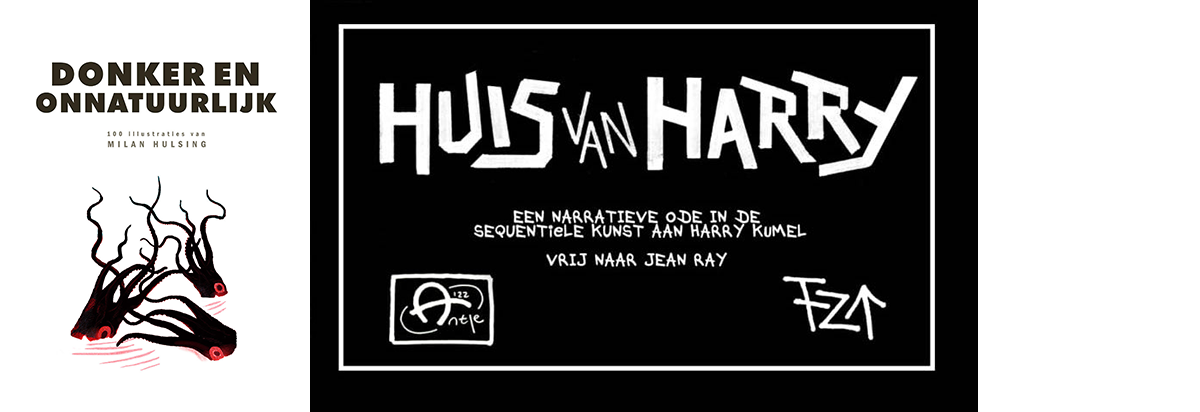
If the latter author has held a boundless fascination for comics and subcultures since his childhood, the next ones go all the way. Written by Antje Y. A. and illustrated by Josse Pommé, the short comic Huis van Harry is an ode to the Belgian filmmaker Harry Kümel. Clearly referencing Kümel’s Malpertuis (1971) with Orson Wellesand featuring Daughters of Darkness’s countess Báthory (Delphine Seyrig), their story can be read on the website of Pulp de Luxe or downloaded free of charge as a PDF version since November.
Earlier last year, the illustrator and comic artist Milan Hulsing published Donker en onnatuurlijk, containing the best drawings from his lesser-known freestyle shadow oeuvre of the past 20 years that’s connected to the world of cult film. Some of these illustrations found their way into the issues and covers of the Dutch film magazine Schokkend Nieuws but are now printed for the first time in a large format over 224 colour pages in this book with linen spine. Among the 100 illustrations, the reader will recognise Joan Crawford, Klaus Kinski, Jack Nicholson, Paul Verhoeven, Stanley Kubrick, Boris Karloff, or The Texas Chainsaw Massacre, Psycho and Fahrenheit 451. Out from Concertobooks, this collection also includes two interviews with Hulsing about his work, and contains a DVD with his hand-painted short film Magic Show (2009, 11′).
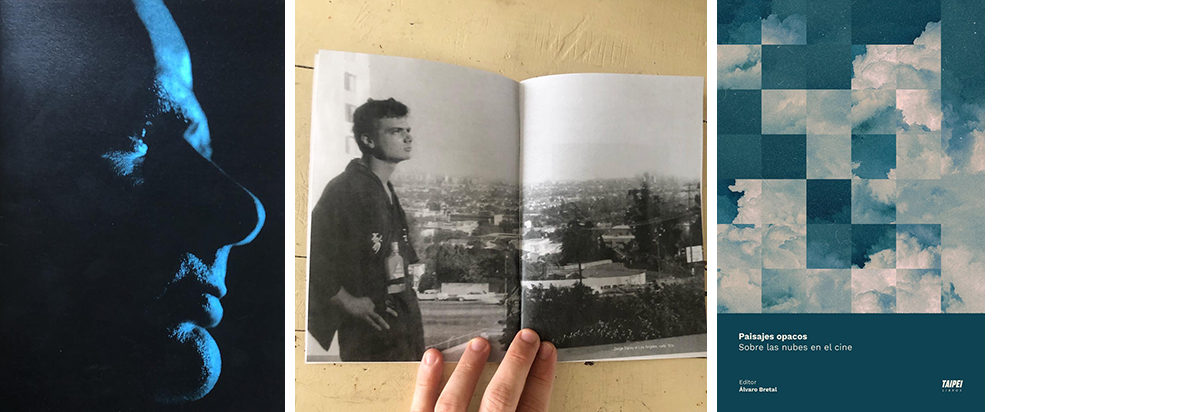
Opening the news in our traditional section on newly-founded or special edition film magazines, the publishing house Semiotext(e) assembled a new, exclusive 40-page Serge Daney zine, featuring pieces written by Marguerite Duras, Jackie Raynal, Jean-Louis Schefer and Philippe Garrel, all newly translated by Christine Pichini. Copies were handed out to all ticketholders of the Daney tribute on October 16 organised by Mezzanine, the great independent film and repertory series in Los Angeles. They are making a tradition out of this, as attendees of their November 16mm screenings of Crystal Gazing (Laura Mulvey & Peter Wollen, 1982) and Tally Brown, New York (Rosa von Praunheim, 1979) also received a limited-edition zine featuring an original text by the music writer Jenn Pelly (Pitchfork, New York Times) and trans queer film historian Elizabeth Pruchell, respectively.
Speaking of film criticism collections, Jonathan Rosenbaum announced in October that he has a contract from Hat & Beard Press to publish his previously uncollected film, literary and jazz criticism in more or less chronological order. This will entail mixing all three, meanwhile theorising about some of the ways in which these arts can be regarded interactively. On his website, you can read an introduction to this collection, In Dreams Begin Responsibilities: A Jonathan Rosenbaum Reader. It’s too soon for a cover or publishing date.
Connected to the Argentinian film magazine Taipei: critica de cine, the new publishing house Taipei Libros launched its first book at the Mar del plata festival last November. Edited by the magazine’s editor-in-chief, Álvaro Bretal, Paisajes opacos. Sobre las nubes en el cine includes ten essays by various authors considering the place of clouds in cinema and the sky as a screen, from John Ford to Béla Tarr, through Brazilian Cinema Novo and the pampean landscape in Argentine cinema.
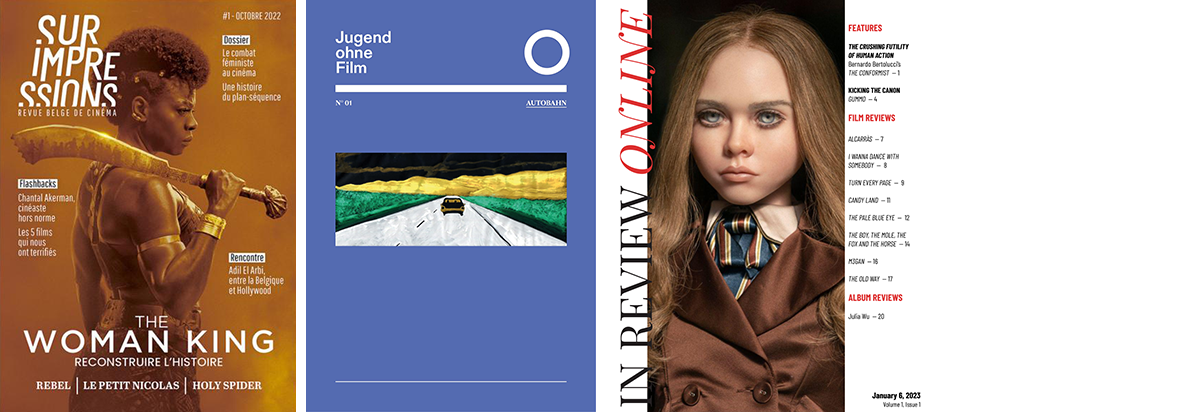
Three film magazines have published a first new issue. In the ever-changing landscape of Belgian film magazines, there’s a new French-language monthly in print, called Surimpressions. After a #0 prototype last May, they’ve launched their first issue in October, and distributed their second, third and fourth issue on November 2, December 7 and January 4. The team felt that “the French-speaking cultural and media landscape lacked a real Belgian film magazine in paper format, as there are three film magazines in print in the Dutch-speaking side of the country and none on the French-speaking side.” They’ve received funding from the Wallonia-Brussels Federation and include advertisements. In around 50 pages, Surimpressions covers eight new film releases, a dossier, an interview, ‘Flashbacks’ and cinema news. The magazine is available free of charge in cinemas and educational and cultural hotspots in Brussels and Wallonia, but you can also choose for a yearly or quarterly subscription.
The German online film magazine Jugend ohne Film also released a first (risograph) printed issue. The approach is completely different from the latter one: “This is a test. You are holding a magazine in your hands. It deals with the world and some films that live in it... Smell the paper... On the following pages, you will find no advertising, no cooperations, no glossy pictures, no judgements, no ratings, no information service, no bending before anything or anyone, no hectically written down guest contributions by venerable luminaries of the cinephile world and film journalism. You won’t find any journalism here at all, that is, no helpless reactions and statements of topicality, and certainly no discourse attributed to the films. Nor will you find a predetermined political agenda or a sentence that had to be shortened due to lack of space. You will wonder what you will find instead. This is where the real test begins. You need to read.” Rejoice! Launched last October at the Viennale film festival, the issue has a focus on the autobahn (highway) and is also available free of charge as a PDF version, although some things can only be found in print.
Already active since 2008, the online film and music magazine In Review Online (InRO) decided to produce a digital weekly, published each Friday, as of 2023. Some of the pieces therein will be published to the website across the following week, while other pieces will be reserved for Patreon subscribers for a period of time. What they earn from this venture will directly go toward compensating their writers, who include Michael Sicinski, Lawrence Garcia, Matt Lynch, Patrick Preziosi, Maximilien Luc Proctor and Ben Flanagan, among others. Volume 1: Issue 1 was published on January 6, the first Friday of the new year.

Launched last October, Abismu is a new online bilingual (!) film magazine (EN/PT) from Brazil. They offer reviews of new films in theatres and streaming (e.g., the co-founder Filipe Furtado on Crimes of the Future), essays (on Julio Bressane, Jean-Luc Godard, Dario Argento), (video) interviews (with the filmmaker Jem Cohen), and a focus on directors (e.g., the Brazilian filmmaker Ana Carolina), genres (contemporary horror) or trends.
Meanwhile, Laugh Motel, the blogsite of the Spanish film critic Cristina Álvarez López, has been celebrating its fourth anniversary. Since last fall, the renewed website now also works on a subscription basis (like a Substack) – 6 euros per month, 60 euros per year, or the equivalent of your national currency. New material is posted twice a month. This includes new writing, English translations of her Spanish-language texts, and experimental digital films. There are also links to other ‘packages’ she has recently developed together with her partner-collaborator Adrian Martin, namely their hour-long multimedia lectures on significant films and their audiovisual essay collections, that have been reworked and technically upgraded and can also be bought individually. There are ten open-access pieces on Laugh Motel that you can sample free of charge.
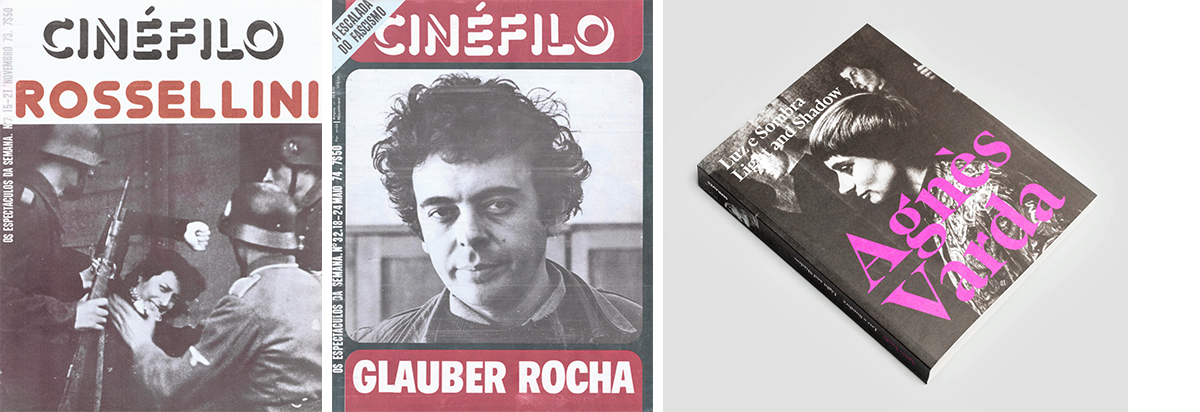
Balthazar, the Danish film journal in print, announced that it will publish its last two issues (#9 and #10) simultaneously on the same day in 2023. One of them will be a special edition dedicated to the work of Danièle Huillet and Jean-Marie Straub, who passed away on November 20. “One of the most beautiful life works in film history is definitely over, and it is appropriate to dedicate the last number of Balthazar to it.”
At the end of 2023, the Casa do Cinema Manoel de Oliveira in Porto also plans to publish a catalogue as part of a large Straub-Huillet focus, including an exhibition, a complete retrospective and a series of conferences. (In France, Capricci’s comprehensive Straub-Huillet retrospective opens on January 18, and plans are being made in Belgium and likely other countries as well.) On the occasion of the current exhibition at the Caso do Cinema Manoel de Oliveira running until February 12, the Serralves Foundation just published the bilingual (EN/PT) book, Agnès Varda: Light and Shadow / Luz e Sombra. Lavishly illustrated, it features original essays, a re-edition of a text by Raymond Bellour and the transcription of two unpublished conversations, one between Agnès Varda and the Swiss curator Hans Ulrich Obrist, and another between the director and Manoel de Oliveira. These pieces are accompanied by a photographic report made by Varda in Portugal in 1956, never before presented in its entirety. Several acclaimed Portuguese chefs have also contributed recipes that have potatoes as their main ingredient...
And to stay in Portugal: On the initiative of Midas Filmes, the 37 issues of the magazine Cinéfilo – which had its second existence between October 1973 and June 1974 – have been made available to browse and read online free of charge. Directed by the filmmaker Fernando Lopes (Belarmino, 1964), Cinéfilo was a unique case in the Portuguese cultural press and particularly in the monitoring of current cinema – for example, by the long interview with Roberto Rossellini on the occasion of the film cycle that the Gulbenkian dedicated to him.

